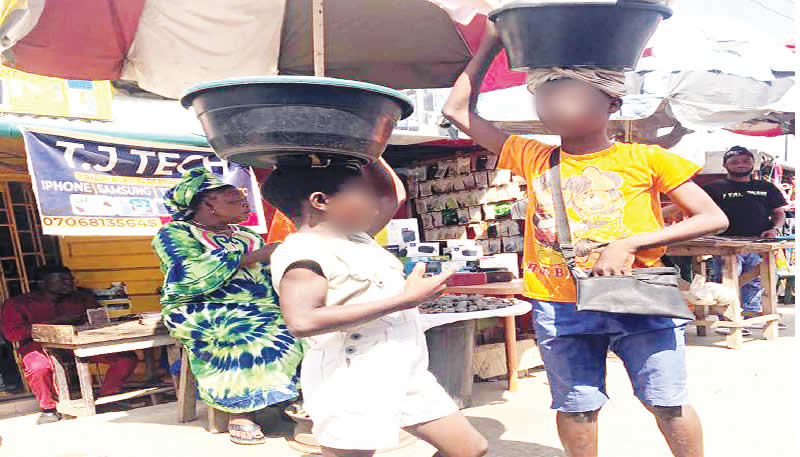
A new report by the National Bureau of Statistics indicating that over 24 million Nigerian children between the ages of five and 17 are involved in child labour demands urgent attention and execution of comprehensive elimination strategies. Despite strides towards progress, the exploitation of innocent young souls persists, staining the fabric of Nigerian society. It is a blight that demands not just attention but decisive action.
According to the Nigeria Child and Forced Labour Survey conducted in 2022, the figure shows that 39.6 per cent of boys and 38.8 per cent of girls are engaged in economic activity or hazardous work. The NBS report cited the worst prevalence in Yobe and Cross River states.
Many of these children work in dangerous environments, including in quarrying, mining, processing minerals, cottage industries, crafts, and construction. They are found hawking and engaging in domestic work.
On the bustling streets and remote corners of Nigeria, countless children toil under oppressive conditions, robbed of their childhood and denied their right to education. From factories to farms, they bear burdens far beyond their tender years, their laughter silenced by the chains of exploitation.
The prevalence of child labour is not just a statistical anomaly; it reflects systemic failures and societal neglect. Poverty, lack of access to education, conflict, and inadequate enforcement of labour laws conspire to perpetuate this cycle of exploitation.
Some children in Nigeria are subjected to the worst forms of child labour, including commercial sexual exploitation and use in war, as well as quarrying and artisanal mining. While legislation exists to protect children, its implementation often falls short, leaving them vulnerable to the whims of unscrupulous employers.
The consequences of child labour echo far beyond individual lives; they reverberate through the very core of the country. Education, hailed as the beacon of progress, is the birthright of every child.
Yet, when children are forced into labour, the light of knowledge dims, casting a shadow on the future of society. Denied education, these children are condemned to a life of limited opportunities, perpetuating the cycle of poverty and inequality.
Moreover, the physical and psychological toll of child labour cannot be overstated. These young souls, subjected to hazardous working conditions and devoid of the carefree joys of childhood, bear scars that may never fully heal. The emotional trauma inflicted on them is a stain on the collective conscience of society, a testament to the failure to protect the most vulnerable class.
Despite various programmes and laws put in place to check child labour, the scourge has been perpetuated by poverty, which compels families to make children contribute to household income.
To add to the mix, some cultural norms see child labour as a way to prepare children for adulthood. However, it is inexcusable to use children as a beast of burden due to the economic crunch in the country. Efforts should be stepped up to address the anomaly.
As of 2022, UNICEF reported that at least 20.1 million childrenare out of school in Nigeria, making it the second-highest out-of-school rate in the world. This is a huge population.
Apart from depriving them of proper childhood, education and skills, children involved in economic activities are exposed to injuries and illnesses. They may grow up without having adequate social interaction and playtime while battling with psychological and emotional distress and low self-esteem. Ultimately, such a dysfunctional childhood would breed maladjusted adults.
Nigeria has a notorious reputation as a source, transit, and destination country for forced labour and sex trafficking of both adults and children. Trafficked Nigerians are recruited from primarily rural areas within the country, with women and girls recruited for domestic work and sex trafficking. In contrast, boys are recruited for street vending, domestic work, mining, agriculture, and begging. All relevant authorities must work together to change this evil narrative.
While it is heart-warming that the Child Rights Act has been domesticated in 34 states, the lax enforcement of the Act has dampened the enthusiasm that heralded the passage of the law and gave hope that the Nigerian child would be protected from abuse, forced labour and early marriage.
As a country, Nigeria cannot turn a blind eye to the injustice against children caught in the web of forced labour. Addressing the problem demands a multi-faceted approach, encompassing legislative reform, robust enforcement mechanisms, and concerted efforts to root out the causes of exploitation.
To achieve measurable results, the government must strengthen its laws to protect children from labour exploitation. This includes stringent regulations on working conditions, age verification mechanisms, and penalties for violators. Regular research and data collection should be conducted to understand the scope of child labour, identify hotspots, and track progress against the mess.
Moreover, society must invest in education and social welfare programmes to provide vulnerable children with alternatives to labour. There should be improvement in the quality and accessibility of education, especially in rural areas, to reduce the likelihood of children entering the workforce.
Equally important is the need for greater awareness and advocacy at all levels of society. Nigerians must challenge the pervasive myths and attitudes that condone child labour and instead foster a culture of zero tolerance towards exploitation. By mobilising communities, civil society organisations, and government agencies, Nigerian authorities can create a groundswell of support for the protection of children’s rights.
Additionally, Nigeria must address the underlying socio-economic factors that drive children into labour. In this instance, economic empowerment and support for families and communities through sustainable livelihood programmes, microfinance initiatives, and social protection schemes to reduce poverty would go a long way in reversing the trend. By addressing the root causes of exploitation, it can break the cycle of poverty and create a brighter future for generations to come.
Raising public awareness campaigns to educate parents, communities, and children about the dangers of child labour and the importance of education is a crucial strategy in the campaign against forced child labour. Governments at all levels must get more children into the school system.
In addition, strengthening child protection systems, including social services, counselling, and rehabilitation programmes for victims of child labour would yield positive results.
Crucially, the authorities – NAPTIP, the police, the immigration service and the Ministry of Labour and Employment – should collaborate with international organisations like UNICEF, the International Labour Organisation and NGOs to leverage resources, expertise, and funding.
Engaging with local communities, traditional leaders, and religious leaders to promote change and encourage collective action; offering alternative vocational training, apprenticeship, and job placement programmes for children and youth and encouraging businesses to adopt ethical practices and ensure their supply chains are child labour-free are practical ways to sustain the fight against the scourge.
The Data Repository, Out-of-School Children Education, Teacher Training and Development, and Skill Development and Acquisition programme recently approved by President Bola Tinubu could help in overhauling the education sector to improve learning and skill development, increase enrolment and ensure the academic security of the children if effectively implemented.













